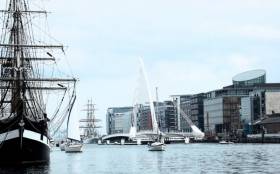Displaying items by tag: Water Animation Strategy
Berthing Licences Join White-Water Course As Part Of Draft ‘Water Animation Strategy’ For Dublin Docklands
#Docklands - The recent design tender for a white-water kayaking course at Dublin’s George’s Dock is part of a wider ‘Water Animation Strategy’ for the city’s Docklands.
Submissions are due this Tuesday 15 May for parties interested in another phase of the draft strategy — this time for vessels of historic or other interest to serve as visitor attractions on the Liffey quays.
Three locations have been identified by Dublin City Council for medium-term lease arrangements, including Custom House Quay at the pontoon immediately east of Sean O’Casey Bridge and immediately west of the Samuel Beckett Bridge, and City Quay immediately east of Memorial Bridge.
Among the proposals welcomed are for historic vessels with an association with the capital or its port; vessels with a community, arts, cultural or leisure purpose to attract visitors; tall ships, including replicas; and ‘visually interesting’ vessels.
Vessels are limited to no more than 50m in length and 7m in height above the water line, excluding masts, funnels, etc. Vessels proposed must be suitable for the location sought, and compatible with existing conditions.
Selections will be made from these expressions of interest for a second stage where applicants “will be invited to enter into competitive dialogue with Dublin City Council for a tender”.





























































